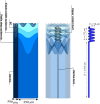Emission from human skin in the sub THz frequency band
- PMID: 35304510
- PMCID: PMC8933490
- DOI: 10.1038/s41598-022-08432-5
Emission from human skin in the sub THz frequency band
Abstract
Recently published Radiometric measurements of human subjects in the frequency range 480-700 GHz, demonstrate the emission of blackbody radiation from the body core, rather than the skin surface. We present a detailed electromagnetic simulation of the dermis and epidermis, taking into account the presence of the sweat duct. This complex structure can be considered as an electromagnetic bio-metamaterial, whereby the layered structure, along with the topology of the sweat duct, reveals a complex interference pattern in the skin. The model is capable of accurately representing the skin greyness factor as a function of frequency and this is confirmed by radiometry of living human skin.
© 2022. The Author(s).
Conflict of interest statement
The authors declare no competing interests.
Figures












References
-
- Fufeng, L. et al. Facial Complexion Acquisition and Recognition System for Clinical Diagnosis in Traditional Chinese Medicine. in 2009 International Joint Conference on Bioinformatics, Systems Biology and Intelligent Computing 392–396 (2009). 10.1109/IJCBS.2009.111.
-
- Baksheeva K, et al. The sub THz emission of the human body under physiological stress. IEEE Trans. Terahertz Sci. Technol. 2021 doi: 10.1109/TTHZ.2021.3066099. - DOI
MeSH terms
LinkOut - more resources
Full Text Sources

